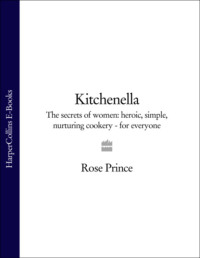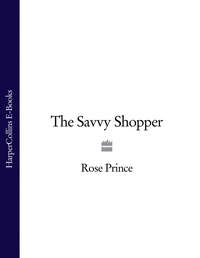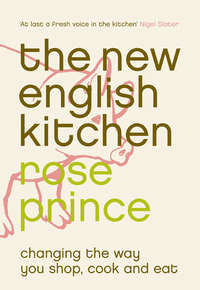
Полная версия
The New English Table: 200 Recipes from the Queen of Thrifty, Inventive Cooking
It is impossible to choose good beef by inspection alone, but joints of native beef tend to be small and the grain finer. The colour of beef flesh varies and does not always relate to a long period hanging on the bone. This is why it is better to buy beef and other meat from a place where you can ask questions about feed, breed and welfare. Ideally, you want to hear that the animal, a native breed, was slowly reared on grass or forage, at a local farm.
Buying beef from local farms reduces carbon emissions, shortens journeys, reducing stress to the animals, and supports the local economy. To find locally reared beef, speak first to your nearest high-street butcher or visit a local farmers’ market. If no joy, look at www.bigbarn.co.uk, put in your postcode and check their area maps, which highlight local producers – but ask specific questions about feed and breed before buying from any of their suppliers.
In London I buy beef from the butcher Jack O’Shea, at 11 Montpelier Street, London SW7 1EX (www.jackoshea.com; tel: 020 7581 7771). He hangs it for weeks and knows everything about cutting in both the Continental and the British way. He is an expert on cheap cuts that can be put on the grill, worth a visit for this alone (see recipes below).
Buying beef via home delivery is another option. Below are producers that I have used regularly:





Beef – the cheap cuts
With beef I need to solve a problem. It is not a meat I eat often because, much as I love it braised for hours until tender, the truth is that I cannot always plan ahead. The kind of beef that it is best to buy, the slow-reared native breeds fed on grass, is pricy stuff. The sirloin, forerib, rib eyes and rump steaks are the easiest meals to make but come at an extraordinary cost. So, to find pieces of the best beef that are affordable for routine meals yet quick to cook, what is needed is an exceptional butcher. Most butchers insist that all cheap cuts must be minced or cut into cubes and slow cooked, but butchers who understand Continental cutting know differently. If the side of beef has been well hung – and this is almost the single most important element in successful beef cookery – it is quite easy to fast cook some of the more extreme cuts.
Cheap cuts on the grill
The following is a new series of recipes, the basic ideas borrowed from European butchery and cooking but adapted to British ingredients. They rely on your willingness to eat the meat medium rare or rare. All are cooked as whole pieces of meat and then sliced. If they are brown all the way through – ‘well done’, as the oxymoron goes in this context – the effect is ruined.
Grilled Goose Skirt with Salad Leaves and Berkswell Cheese
Goose skirt is a dark meat with a wide grain (it is a different cut from the plain flank or skirt in the recipe on here). It is essential that the beef has been well hung. If seared quickly, it will be very tender. Serving it with leaves and a hard, mature ewe’s milk cheese is a good antidote to the richness of gravies and butter sauces. You could substitute Lord of the Hundreds, Somerset Rambler or Italian pecorino for the Berkswell.
Serves 4
750g/1lb 10oz goose skirt steak, left in whole pieces
4 large handfuls of young salad leaves
4 tablespoons extra virgin olive oil
115g/4oz mature Berkswell cheese. pared into thin slices
sea salt and freshly ground black pepper
Have ready 4 warm (but not hot) plates. Season the beef with salt and pepper. Heat a ridged grill pan until smoking, then sear the beef for about 2 minutes per side. Ideally, it should be eaten very rare in this dish. Transfer to a wooden board, leave to rest for a minute and then slice thinly. Lay the slices on the warm plates, scatter the leaves on top and shake over the olive oil. Put the pared cheese over the top and eat immediately.
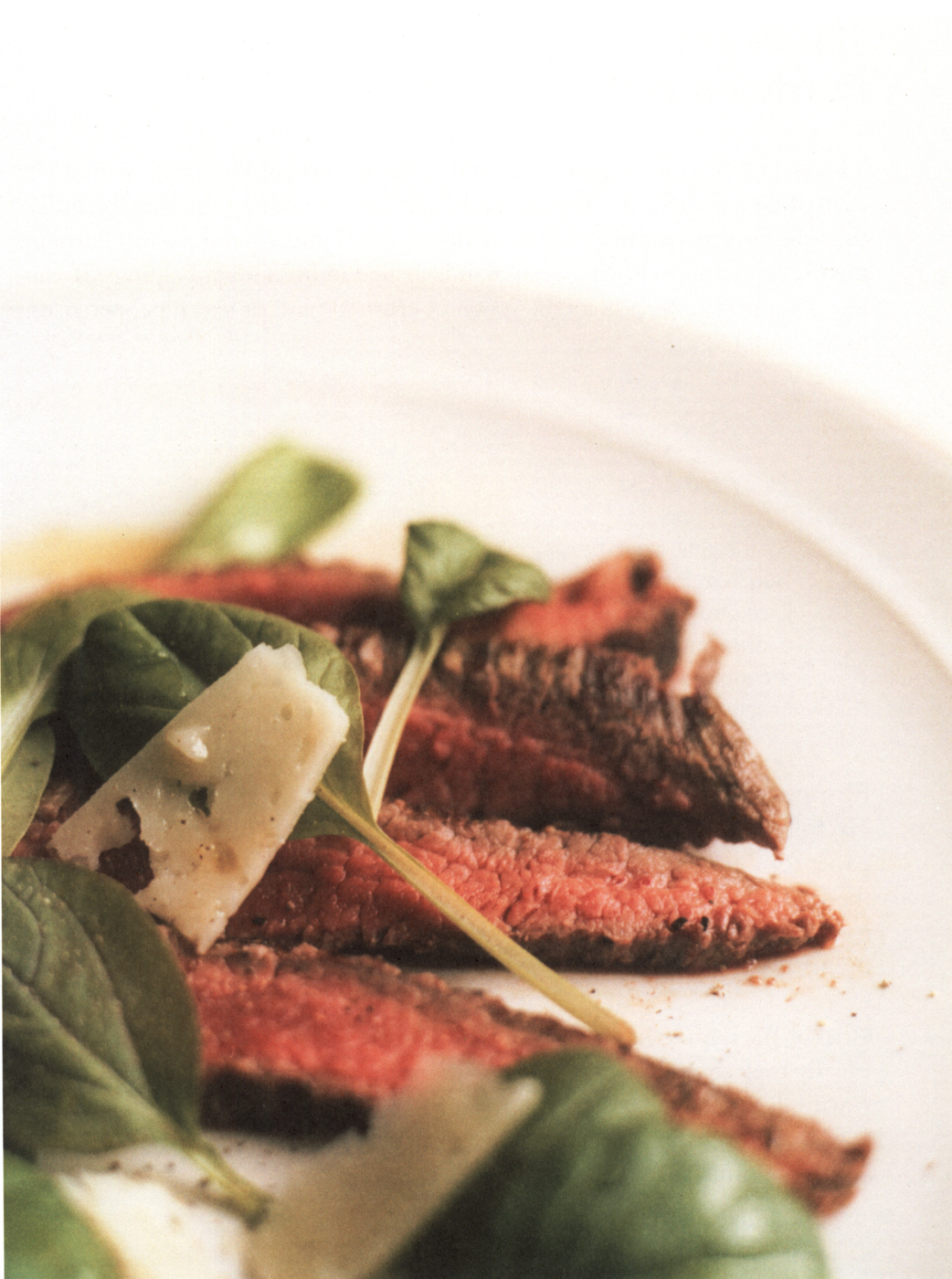
Top of the Rump with Lemon and Parsley Butter
This is a tender muscle, taken from the cheaper end of the rump, with a strip of fat attached. In Portugal and Brazil it is known as the picanha, and thought far superior to a rib-eye or fillet steak. Unlike the skirt and flank in the previous and following recipes, it is grilled in individual helpings. If you like a peppery taste, add a tablespoon of crushed pink or green peppercorns to the butter.
Serves 4
4 top rump steaks
For the lemon and parsley butter:
140g/5oz unsalted butter, softened
juice and grated zest of ½ lemon
a large handful of very finely chopped parsley
freshly ground black pepper
First prepare the butter, putting all the ingredients in a bowl and stirring carefully until well mixed. Place the mixture between 2 sheets of greaseproof paper (or 2 butter papers). Roll it to about 1cm/½ inch thick and put it in the fridge to harden. When hard, remove from the fridge and use a small, round biscuit cutter to cut out discs (or other shapes). Leave the discs in the fridge.
Grill or fry the steaks, seasoning them with a little black pepper first. Ideally they should be served rare (see guide on here). Leave to rest in a warm place for about 10–15 minutes. Warm 4 plates. Serve the steaks with a disc of the lemon and parsley butter melted on top. Have some English and Dijon mustard ready on the table.
Flank with Tarragon Butter Sauce
Sometimes called skirt or bavette, flank is a cut taken from the diaphragm muscle of the beef animal. Here it is grilled whole, then sliced and served with a buttery sauce sharpened with shallots and vinegar. It must be cooked so it is rare in the centre or it will be dry. If you like steaks well done, I am afraid you will have to use conventional rump or sirloin.
Making the sauce requires a certain amount of patience, and a small, heavy-bottomed pan to prevent overcooking. It can be made in a food processor, however, if the butter is melted first and trickled in warm. Serve with green vegetables – the courgette salad is good, fried potatoes even nicer …
Serves 4–6
2 whole pieces of flank
a little olive oil
freshly ground black pepper
For the tarragon butter sauce:
4 tablespoons tarragon vinegar
4 tablespoons dry white wine
2 shallots, finely chopped
3 egg yolks
175g/6oz unsalted butter, at room temperature
a small handful of French tarragon leaves, chopped
sea salt and freshly ground black pepper
Season the beef with pepper, then rub it with a little olive oil. Set to one side (leaving it at room temperature).
Put the vinegar, white wine and shallots into a small, heavy-bottomed pan and heat to boiling point. Simmer until the liquid has reduced to 1 tablespoon, then remove from the heat and add 2 tablespoons of cold water. Leave to cool, then mix in the egg yolks.
Return the pan to a very low heat and whisk in the butter, one hazelnut-sized piece at a time, until the sauce is thick and glossy. Add the tarragon, then taste and season with salt and pepper. If it becomes grainy or begins to ‘split’, add a dessertspoon of iced water and whisk hard. Once made, the sauce will remain stable for half an hour or so if kept in a warm place; just whisk again before serving.
To grill the meat, set a ridged grill pan over a high heat. When it begins to smoke, lay the meat on the pan and cook for 2–3 minutes on each side, turning down the heat a little if it becomes too smoky. The meat will be rare in the centre. Remove from the heat and leave to rest in a warm place for 10 minutes. It should not be so warm that the beef continues to cook. Meanwhile, warm some dinner plates.
To serve, slice the beef across the grain and place a few slices on each plate, with a dollop of sauce beside it.
How to grill or fry meat
Very rare Sear the steak on both sides; a finger pressed on the surface will leave an indentation.
Rare Sear one side, then continue to cook until droplets of blood are visible on the surface. Turn the meat and cook the other side for an equal time. Some resistance should be felt when pressing a finger on to the surface.
Medium Sear one side, wait until juices (not blood) begin to emerge on the meat surface, then turn and cook the other side.
Other cheap cuts
The onglet is a muscle that connects the last rib to the kidney. It is brownish in colour and there is a faint delicious flavour of kidney. It is not generally used as a grilling steak in the UK, but if you visit a Continental butcher they will know it immediately – if not as onglet (the French name), then perhaps as lombatello (Italian), or solomillo de pulmón (Spanish). In America it is known as the hanging steak. A keen British butcher, with experience in cutting the Continental way, may be able to prepare it for you. Have a discussion when he hasn’t got an enormous queue.
The onglet weighs about 500g/1lb 2oz and, when trimmed of gristle, it can be grilled or roasted whole (but left rare in the centre), then sliced and served with any of the sauces in the previous two recipes.
In Cork City in Ireland, butchers cut a muscle from the shoulder called the Jewish fillet. It is removed whole and totally trimmed of any connecting tissue or gristle, then – as with the other cuts – grilled whole and sliced. It can be served with the lemon and parsley butter, or with the tarragon butter sauce.
Other butchers elsewhere will have different names for the cuts in the recipes above. I once saw an Italian butcher cut the shoulder muscle as above, but my Italian was too appalling to ask about the name for it. Some butchers call onglet thin steak, others call it feather steak, because it is a V shape with grains leading from a central join. Disagreement over the terms leads only to a healthy debate between butcher and customer – I advise getting stuck in.
Cheap cuts in the pot
Almost any forequarter beef or shin meat is suitable for a slow braise. This is easy territory for butchers, who have loads to spare and are longing to get rid of it. If you can make time, encourage the butcher to give you some of the bones, to roast and then simmer with water the day before the braise so you have a ready supply of stock. Preparing stock takes just minutes – then all you have to do is wait until the pot has done its work.
Braised Shin of Beef with Ale
A slow simmer of beef is the best winter food. Supplemented with mash and piles of roasted root vegetables, a little goes a long way towards feeding a big table of people. Bread brushed with dripping or olive oil and rubbed with garlic, then baked until crisp, can be put in baskets on the table. Make sure you have handfuls of parsley to scatter over the top. If you want to be more adventurous still, grate a little orange zest into the parsley. In February use the zest of blood orange, which is somehow just right with red meat.
Serves 6–8
5–6 tablespoons olive oil or dripping
2 garlic cloves, chopped
2 onions, finely chopped
2 celery sticks, finely chopped
2kg/4½lb braising beef, cut into 4cm/1½ inch chunks
1 bay leaf
a pinch of dried thyme
2 parings of orange peel
600mt/1 pint real ale
2 tablespoons plain flour
beef or other meat stock, to cover
sea salt and freshly ground black pepper
Heat about a third of the fat in a large, deep pan and gently cook the garlic, onions and celery in it until soft. Remove the vegetables with a slotted spoon and set aside. Add more of the fat to the pan, turn up the heat and brown the beef on all sides, cooking it in batches and setting it aside as soon as it is done. Add more fat as necessary. Add the herbs, orange peel and ale to the pan and bring to the boil, scraping away at the base of the pan with a wooden spoon to deglaze it. Return the meat and vegetables to the pan, sprinkle with the flour and stir well. Add enough stock to cover, then stir and bring to the boil, skimming off any foam that rises to the top. Turn down the heat to a slow bubble and cook, covered, for 1½–2 hours, until the meat is tender. Skim off any fat. Season with salt and pepper to taste.
Cold Salt Beef and Green Sauce
If you are lucky enough to know a butcher who puts brisket and silverside in a brine cure, it is an easy and quite economical dish to cook for one meal. Hopefully, there will be leftovers for following days, to eat in sandwiches with mustard or as a salad with a herb sauce.
Serves 6–8
1.5-2kg/3¼4½lb piece of boned. rolled salt-cured silverside or brisket
1 clove
1 star anise
1 bay leaf
For the green sauce:
5 sprigs of parsley, chopped (or chervil, if you can find it)
3 sprigs of tarragon, chopped
4 sprigs of basil, chopped
about 2 tablespoons chopped chives
1 tablespoon chopped cornichons (baby gherkins)
1 heaped teaspoon capers, rinsed and chopped
1 teaspoon Dijon mustard
6 tablespoons olive oil
sea salt and freshly ground black pepper
Soak the beef in cold water for a few hours or overnight, changing the water once or twice. Drain the beef and put it in a large pan with enough water to cover. Add the clove, star anise and bay leaf, bring to the boil, then turn the heat down so the water is barely boiling – ‘murmuring’ is a good description. Simmer for 2–3 hours, until the meat is tender when pierced with a knife. Lift out, wrap in foil and leave to rest for a good hour.
To make the sauce, mix all the ingredients together, seasoning with salt and pepper to taste.
Serve slices of the lukewarm beef with the sauce and a potato salad. You could make the bacon and potato salad, omitting the bacon.
Beef – the valuable cuts
Now and again I turn to the special parts of beef for food to feast on – the sirloins, fillets, rump steaks and forerib. All can be cooked quickly, can be eaten rare and never toughen. Eating a grilled steak is an easy task – sometimes too easy with fillet steak, which can be tender to the point of dullness and lacks the flavour of a good rump steak.
These cuts form a small percentage of the meat on a beef animal, and have prices that match their economy of scale. Economic to buy they are not. It is not unusual to see well-trimmed fillet sold at over £35 per kilo. That’s more than £8 per helping, so it is a meal that I will not serve for supper any old day.
What matters is to recognise that these are not cuts that should be eaten every day, even if your means make them affordable. A farmer goes to immense trouble over the years to rear a steer to perfection, yet there is only enough fillet to feed about 20 people from it. A butcher must trim off a good proportion of the fillet once it has been extracted from the carcass, because it is unsaleable with the untidiness of stray pieces of beef and some membrane. This meat is chucked into the mince and sold for pence, not pounds. For every fillet in a beef side there’s an awful lot of much less valuable meat that is a hard job for the butcher to sell. It’s not really acceptable for someone who says they love beef to eat only the fillet or sirloin. Demand for fillet is a demand for a whole animal to be reared and slaughtered and there is – bossy as it sounds – a collective responsibility to find uses for the other cuts. I am not suggesting buying the whole cow, but you can buy beef boxes from some butchers and mail-order services. You can also ask for bones. They are free, and a source of good stock, marrow or even canine happiness. Butchers and meat producers pay to have bones and waste material removed and disposed of.
So, if I haven’t made you feel too guilty …
Roast Rare Aged Beef Sirloin with a Mustard and Watercress Sauce
Now that the Over-Thirty-Month rule has been lifted, it is possible once again to buy beef from steers that have reached their full maturity. So we now have four-year-old beef and it is unbelievably good, both to cook and in its vintage flavour. I buy four-year-old well-hung Galloway beef from Ben Weatherall, of Blackface (see Buying beef). Its texture and the way it cooks so beautifully, barely losing an ounce as it roasts, is confirmation that growing an animal slowly is the best approach to rearing beef.
When you buy your sirloin, ask the butcher for the ‘cradle’ of detached ribs for it to sit in as it roasts; they can be used to make stock for other dishes.
Serves 6
1.25kg/2¾lb whole piece of rolled sirloin
fennel seeds
6 small sprigs of thyme
sea salt and freshly ground black pepper
For the mustard and watercress sauce:
leaves from 2 bunches of watercress
1 tablespoon English mustard powder
2 tablespoons white wine vinegar
4 tablespoons chicken stock
1 shallot, roughly chopped
1 garlic clove, roughly chopped
200ml/7fl oz olive oil
lemon juice
Allow the beef to come to room temperature before you begin roasting. Preheat the oven to 240°C/475°F/Gas Mark 9.
Season the beef all over and put it in a roasting tin. Scatter the fennel seeds and thyme on top. Put in the oven and roast for 10 minutes, then turn the heat down to 175°C/350°F/Gas Mark 4 and continue roasting for about 30 minutes. Remove from the oven and test for doneness. To do this, insert a skewer into the thickest part of the meat, leave it there for 1 minute, then take it out and test the temperature of the skewer by touching it with your finger where it would have been in contact with the centre of the sirloin.
For rare beef, it should be above blood temperature (about 50°C/125°F if you use a meat thermometer) – this is not a dish to eat well done. If the meat is cooked, remove from the oven and leave for a good 20 minutes to rest. If not, return it to the oven for 10 minutes and then test again.
Meanwhile put the watercress, mustard, vinegar, stock, shallot, garlic and oil in a liquidiser and blend until smooth. Taste and add salt if necessary. Finish with a squeeze of lemon juice and stir well.
Carve the beef in thick slices and serve with the sauce in a bowl on the table so everyone can help themselves. Serve mustard, too – and have a big leafy salad afterwards.

Raw Beef with Horseradish, Sorrel and Rye Bread
Two years ago I travelled to Copenhagen on an assignment. The story was a young chef whose restaurant, Noma, was attracting much attention. Rene Redzepi has since won awards for his curious cooking, which uses only Nordic raw materials on a strictly seasonal basis. He made a ‘tartare’ similar to this one, and advised that we should eat it with our fingers. I recommend it (if occasion allows); somehow the absence of a cold fork is just right. It is a nice primitive way to eat a dish that feels northern European down to its boots, yet would not be out of place in Venice.
Redzepi made this with the fillet of a Musk Ox, a native Greenland breed. With none to hand, seek out any of the pure native British breeds: Angus, Hereford, Red Poll, Galloway, Devon, Highland, Welsh Black, White Park, Dexter and so on. Use only beef that has been hung for a minimum of three weeks, preferably four.
Serves 4
450g/1lb prime fillet beef
4 small pinches of sea salt
4 thin slices of rye bread, each slice trimmed of the crust and cut into 4 squares (pumpernickel is the closest alternative to Danish rye bread)
4 tablespoons olive oil
2 tablespoons grated fresh horseradish
a handful of sorrel leaves – or sorrel sprouts (see Kitchen Note below)
2 shallots, very thinly sliced
1 tablespoon juniper berries
1 teaspoon coriander seeds
1 teaspoon caraway seeds
For the tarragon sauce:
6 sprigs of tarragon
1 tablespoon white wine vinegar
1 tablespoon chicken stock or water
½ shallot
½ garlic clove
150ml/¼ pint olive oil
lemon juice
sea salt
Begin with the tarragon sauce. Put the tarragon, vinegar, stock or water, shallot, garlic and oil in a liquidiser and blend to a smooth cream. Season to taste with salt and a few drops of lemon juice, then refrigerate.
Using a very sharp knife, ‘scrape’ the meat into fine strips along the grain, parting the grain. Divide it between 4 serving plates. Sprinkle each portion with a small pinch of salt. Fry the rye bread lightly in the oil, then scatter it randomly over the beef, followed by the horseradish. Finish off with the sorrel and sliced shallots.
Heat the spices in a deep frying pan until they begin to brown, then grind to a fine powder using a mortar and pestle or a redundant coffee bean grinder. Put a large pinch of the spice mixture on the side of each plate. Serve with little bowls of the sauce to one side of each plate, eating the tartare with your fingers by taking a pinch of the raw meat and dipping it first in the sauce, then in the spice.

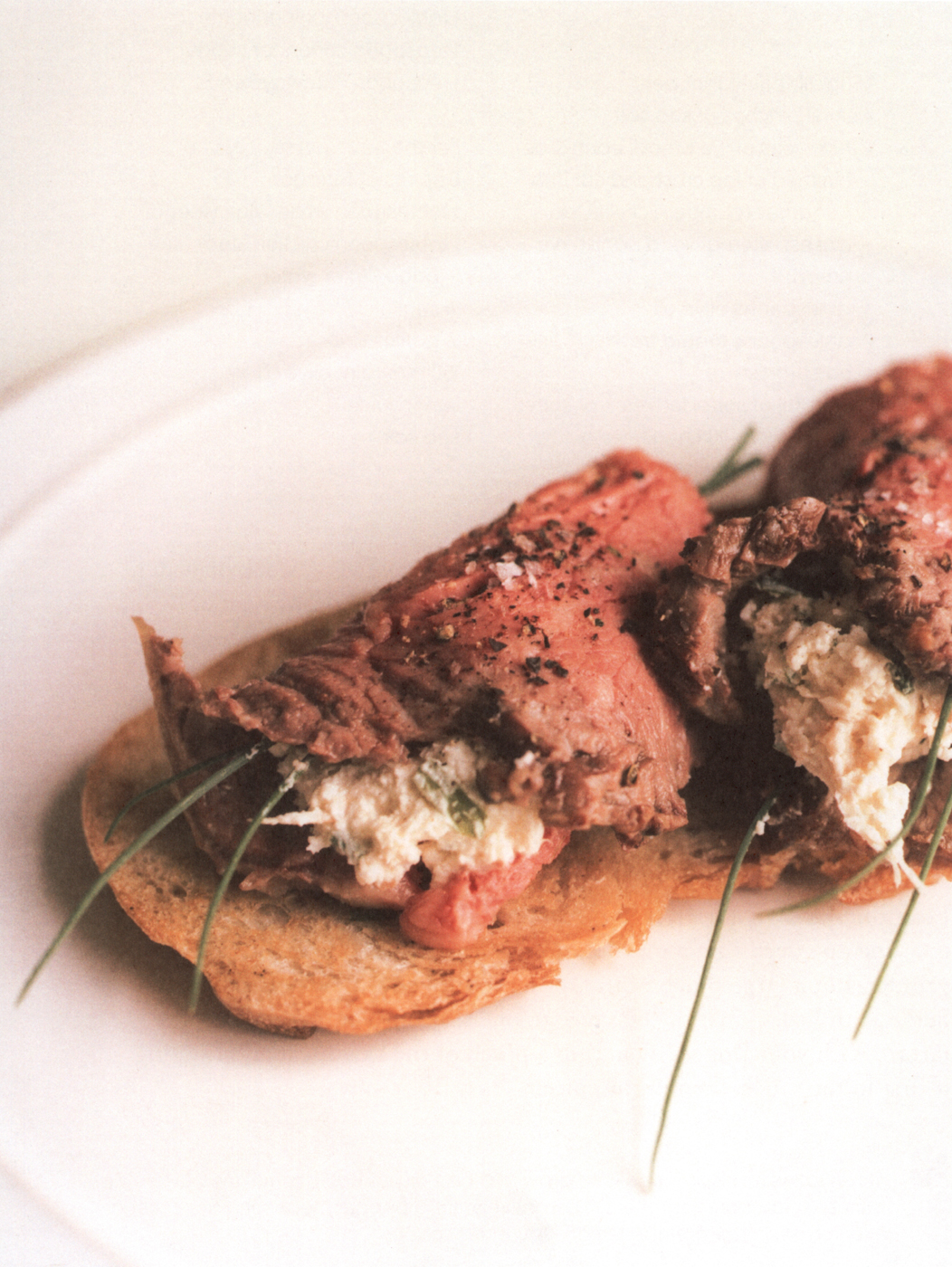
Beef leftovers
In 2006 a stunning statistic revealed that the average person throws over £400 worth of food away each year, and I’ll bet a proportion of that will be leftover meat, carcass bones and fat. If, after reading the introduction to the beef section, you are convinced that spending more on naturally reared beef is essential, then absorb the extra spend by making use of the leftovers. This food is a bonus, and a strong point in favour of the argument that good eating is more a question of knowing what to do with food than one related to money.
Cold meat
Beef with Horseradish Sauce on Crisp Bread





